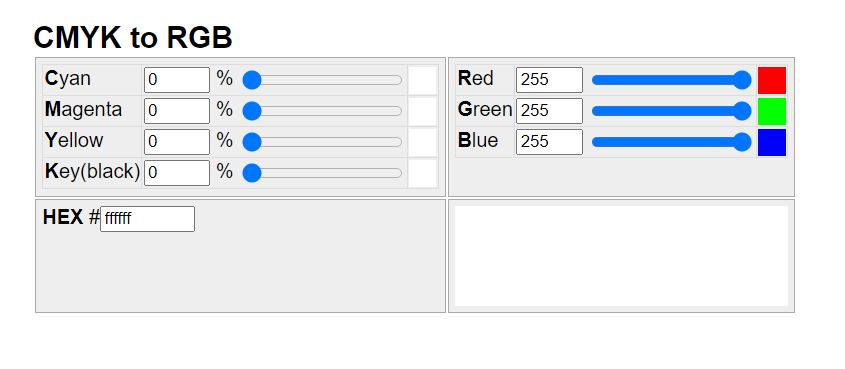Could you want to transform the CMYK color to an RGB version?
That is a free online shade code converter, that remodels a shade hue to another shade version. and supports three color models, CMYK, RGB, and HEX, which can be converted to every other.
- CMYK to RGB and HEX
- RGB to CMYK and HEX
- HEX to RGB and CMYK
The way to use this converter
- Input your color codes in anybody coloration version location, CMYK, RGB, or HEX
- To transform CMYK to RGB, enter your CMYK coloration codes to CMYK vicinity, as an example, CMYK(100%, zero%, 33%, 40%)
- To convert CMYK to HEX, input codes to the CMYK vicinity
- To convert RGB to CMYK, input your RGB color codes to RGB location, for instance, RGB(30, one hundred, 220)
- To convert RGB to HEX, enter codes to RGB place
- To transform HEX to CMYK, input your HEX shade codes to the HEX region, as an instance, #3b5376
- To transform HEX to RGB, input codes to the HEX area
- Our color code converter will show results interactively
A way to convert CMYK to RGB
The pink, green, and Blue values are given in the variety of 0..255, the crimson color(R) is calculated from the cyan(C) and black(okay) colors, the green color (G) is calculated from the magenta(M) and black(k) colors, The blue coloration(B) is calculated from the yellow(Y) and black(okay) hues. Below are the components of CMYK to RGB conversion
- Red = 255 × ( 1 – Cyan ÷ 100 ) × ( 1 – Black ÷ 100 )
- Green = 255 × ( 1 – Magenta ÷ 100 ) × ( 1 – Black ÷ 100 )
- Blue = 255 × ( 1 – Yellow ÷ 100 ) × ( 1 – Black ÷ 100 )
How to convert RGB to CMYK
The max number of R, G, B values are 255, first of all, we divided them by 255 to become the number of 0~1, this ratio will be used in the calculation.
- Rc = R ÷ 255
- Gc = G ÷ 255
- Bc = B ÷ 255
The black key(K) color could be many result, when we assume a black key value, the other three colors(cyan, magenta, yellow) can be calculated. we can calculate it from the red, green and blue colors, the max number of the black key should be :
or we can assume we run out of the black ink, need use the remaining other three color inks to finish the printing job.
The cyan color(C) is calculated from the red and black colors:
The magenta color (M) is calculated from the green and black colors:
The yellow color(Y) is calculated from the blue and black colors:
CMYK and RGB
The CMYK coloration model is used in the printing process. To understand it, it’s far fine initially RGB coloration. The RGB coloration version (made of red, green, and blue) monitor is what you’ll view your tasks in even as nevertheless on the display screen. natural or produced mild This is wherein CMYK is available.
Convert CMYK to RGB
Photograph designers should deal with the difficulty of seeing their paintings on a display screen in RGB, although their very last published piece could be in CMYK. Virtual files have to be converted to CMYK earlier than sending to printers, except in any other case specific. Due to this problem, it’s miles crucial to use “swatches” while designing if precise shade matching is essential. Swatches offer a dressmaker and client with a broadcast instance of what coloration will look like on paper.
Even though the on-display colour might not exactly healthy the swatch, you know what your final color will seem like.
Difference between RGB and CMYK
“We constantly get questions from customers in connection with net colors they view on display screen and what they see in brochures and other print media.” RGB and CMYK are the two most outstanding and traditional shade spaces/formats/models used inside the world of the layout. In print, net, or virtual media, a primary expertise of what the variations are, means a fledgling designer can massively enhance the fine of a challenge.
The procedure of addition can create hundreds of thousands of different colorings by using various concentrations of the primaries. Possibilities are any picture you get hold of could be RGB by default, however, it’s constantly an excellent practice to check.
RGB shade device is handiest appropriate for display reproduction along with liquid crystal display and CRT pc monitors and television displays. This isn’t appropriate color matching for printing or to shade match from, as every screen may also represent colours in another way. What may also look high-quality on one display, maybe an appearance completely distinctive on some other.
Additive coloration models use transmitted mild to show color. Monitors use the RGB colour version. When you add red light, blue light, and inexperienced mild together so that the cost of each aspect is 255, the coloration white displays. While the fee of each aspect is 0, the result is pure black.
CMYK/manner – digital printing
The CMYK, also called process colorations are usually used in digital printing. CMYK refers to the 4 colors used; Cyan, Magenta, Yellow and Black to generate a color. One thing to notice is that CMYK hues might not appear identical to physical shades due to the restriction to the number of colors CMYK can reproduce and that Inks carry out in a different way.
As an example, orange is very hard to breed and can appear very muddy in while revealed digitally. We take care to check in all photos with our 4 shade bars carried out to all printing we do. In this manner, the manufacturing team can quickly and visually test the print at exceptional stages. It’s far a generation thing. The CMYK coloration model defines color in the usage of the subsequent additives:


